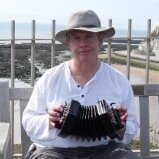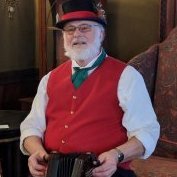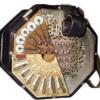-
Posts
257 -
Joined
-
Last visited
Contact Methods
-
Website URL
http://justanechoonthewind.blogspot.co.uk/
-
ICQ
0
Profile Information
-
Gender
Male
-
Interests
Traditional English and Irish folk music. Old Time.
-
Location
south-east England
Recent Profile Visitors
1,619 profile views
frogspawn's Achievements

Chatty concertinist (4/6)
-
frogspawn started following Do you play other instruments?
-

Do you play other instruments?
frogspawn replied to Greg Mirken's topic in General Concertina Discussion
Besides Crane Duet (and briefly an Anglo), I play Irish Bouzouki, Guitar, Tenor Banjo (Irish tuning), Mandolin/Banjolin, Medieval Lute and sing Acapella. I also own and have dabbled with Appalachian Dulcimer, 5-String Banjo, Melodeon, Cigar Box Guitar, Tin Whistle (Low and High), Keyless Flute, Thee-Hole Pipe and Tabor, and Harmonica. The instruments I use most are the Bouzouki and Crane for Trad Folk song accompaniment and the Guitar for Old Time song accompaniment. -
frogspawn changed their profile photo
-
Just caught up with this thread and am most grateful for the more recent contributions from Kurt and Geoff. My return to concertina playing was delayed for personal reasons but I'm reasonably confident I can make a better job of it this time. Rik
-
I'd expect any English tunes session in the UK to be heavily G and D biased and wouldn't want it any other way!
-
As the OP probably most responsible for kickstarting the current round of interest in this area (even if I never get round to following it up myself), I am also disappointed that this is not receiving more support. When I came back to CNet after my years away from the concertina I was a little concerned that nothing much had appeared to change, particularly in the area of modern tutorial literature. The concertina cannot be that obscure. For all other instruments, YouTube and the web in general is packed with free instructional videos of the highest quality and there is plenty of subscription material too. Are concertina players uninterested in growing the community of enthusiasts? Have they all found what they want and are content to keep it to themselves? There is so much to be gained from sharing and collaboration. I don't extend this disappointment to ITM which always seems to have had an enthusiastic and organised base with plenty of good material and the availability of top class instruction, but I fear that Enlish folk concertina outside maybe melodic playing for Morris sides seems destined to go the way of the rest of the English Folk Revival, i.e. shortly to the grave. I guess that for English concertina there are teachers around, and I don't expect too much for my own obscure choice of duet. (I would be perfectly happy to share the fruits of my own limited experience through my own personal blog in due course, but I've only just started out on the road to relearning it and am quite unsure as to what direction will prove the most fruitful.) I don't mean to ruffle any feathers here. Well, perhaps I do as to get some reaction would be better than getting no reaction at all. Of course, if people just want to do their own thing then that is their business. On the other hand belonging to a forum would suggest a desire to exchange information and to be active in promoting our shared interests. I can see there are others, but perhaps very few in numbers, who share my frustrations!
-
When I first started learning the Crane - which was really my first serious instrument - my practice approach was seriously flawed. Alan Day certainly put me right on some aspects but the damage had already been done. I had wasted years of effort which could have been used more efficiently. I made a better job of the Mandolin, working out some of my errors for myself. Then I came across 'The Practice of Practice: Get Better Faster' by Jonathan Harnum which I think is a vital book to escape the potential errors in being self-taught. I don't know if it's been duscussed here before - I didn't find it in the forum search, but even if it has it's a book worth going back to periodically. Maybe its basic principles are taken for granted by everyone else, but as a complete musical novice with no formal training I was amazed how much fundamental wisdom I had missed, such as: 1. Playing so slowly that you cannot make a mistake and thus do not reinforce errors. 2. Focusing on the difficult bits rather than playing a whole piece from the top when you go wrong. 3. Always innovating rather than repeating the same old things. Rik
-
It’s good to see things moving forward in this area. There is definitely a gap in the market. The tunes in Nick Barber’s collections are excellent. Another collection popular in south-east England is the Lewes Favourites. Rik
-
The first thing I'm trying is an accompaniment on the left. I'm hitting the root note of the chord on the first and third beats and then the 3rd and 5th notes of the chord together on the second and fourth beats. It's like an oom-pah but doesn't use bass notes. The song I'm working on is in C, so for the C chord I'm alternating C4 with E4+G4. Following the way mandolin chords are described but starting at the bottom end of the keyboard, I notate this chord shape as X443X or 443 if not using the outside columns. To keep things simple I use the same shape for F (554) and G (332). For melodic breaks I'm droning power chords on the left, i.e. X43, X54 and X32 for C5, F5 and G5 respectively, while playing the melody on the right in the upper octave. This is all very straightforward and seems to produce an acceptable sound. Rik
-
Thanks to all for the suggestions. Kurt, I found that hitting bass notes and high chords on the left (as I believe you originally advocated and demonstrated some years ago) was too much of a jump for me, but bass notes on the left and chords on the right should be easier to find. It also means my right hand will be actively engaged and ready to switch to melody for the fills. I try to learn from both Andrew McKay and Geoff Lakeman, both of whom I've met and spoken to in the past. I have their recordings and access to videos of Geoff on Youtube but still find it hard to work out what they are actually doing! Geoff very kindly gave me some time after a gig. He mentioned partial chords, and, I think, walking bass lines.
-

Balance of C/G vs G/D Anglos in English sessions?
frogspawn replied to frogspawn's topic in General Concertina Discussion
Don I hesitate to digress, but since you ask... The Crane is a brilliantly logical and versatile design. You can play it from dots and all the notes are there. The downside is that your fingers need to do a lot of running around to reach them. I guess it's good for hymns, but it's hard to keep up in sessions. The other problem is volume. -

Balance of C/G vs G/D Anglos in English sessions?
frogspawn replied to frogspawn's topic in General Concertina Discussion
While searching through old threads on this forum I realised I had asked the same question four years ago! Well four years is a long time when you've been doing other things, but it does show that the Anglo keeps drawing me back. I see that I got much the same response then but I didn't follow it up, possibly because the pros and cons are not entirely straightforward... -

Balance of C/G vs G/D Anglos in English sessions?
frogspawn replied to frogspawn's topic in General Concertina Discussion
If you use a C/G tutor for a G/D, the Standard Notation becomes completely misleading and you will need to relearn it when you go beyond the tutor. Just using tab also raises questions. If, say, a G tune is played melodically entirely along one row, then transferring it from G on a C/G to G on a G/D is reasonably straightforward, but if any chords or cross-rowing is involved the experience will be different. Different C/G tutors also use different systems of tablature, adding to the complications. Perhaps none of this really matters. If you are only learning one tune at a time you can rewrite everything. Also, if you are playing by ear you don't need the notation. -

Balance of C/G vs G/D Anglos in English sessions?
frogspawn replied to frogspawn's topic in General Concertina Discussion
One thing puzzles me. If the G/D, played harmonically, is the instrument of choice for English sessions, why aren't there any tutors for that? I understand Pip Ives' book is for G/D tuning but addresses only melody playing. Otherwise everything seems C/G orientated and requires some degree of translation. Whilst I appreciate that a G/D can be played as a transposing instrument, it becomes very confusing when you want to follow new scores in the real world keys. -
Trying options and making them sound good remains uncharted territory. More popular instruments enjoy a wealth of video instruction detailing every note and finger movement, but AFAIK nobody is going to tell me note by note, button by button and finger by finger how to pull this off on a duet concertina. You have to make that up for yourself which is exciting if you make progress but frustrating if you don't. I feel slightly more confident this time round, but specifically how to get the sort of sound I want is currently a mystery, although I have a number of ideas I want to experiment with. To begin with, however, achieving any sort of adequate and competent backing will do.
-
I've been taking a sabbatical from the concertina to play the mandolin. This has hugely improved my sense of rhythm and feel for chords. Now I want to try the concertina again. The Crane requires a lot of finger movement and I find it hard to play tunes fast enough without fumbling, so this is partly why I'm looking at the Anglo (the system I originally started with) for English instrumental sessions. I do, however, want to revive my use of the Crane for song accompaniment, but I need to find a completely new method. My old style involved playing the full melody with full chords. It tended to drown my singing and was too complicated, so I want to develop a sparser approach which is quieter and less likely to go wrong...
-

Balance of C/G vs G/D Anglos in English sessions?
frogspawn replied to frogspawn's topic in General Concertina Discussion
Thanks to everyone for your responses which strongly point to a G/D for English sessions. My first concertina was an Anglo but then I went down the Crane route...



